Old French Bass full Restoration
Re: Old French Bass full Restoration
Matthew, there is not wrong and lots to be proud about being about to do it "old school". I remember my mother reading an article in National Geographic about ancient Egypt. She shared a bit about their jewelry. Here we were all these thousands of years later and despite all our advancements, we still couldn't figure out how they did it.
Being able to work old school is a gift, especially if the power goes out. Lots of us are able to build an instrument because we have tooled up to do it. If someone cut the power to my shop I'd be at a loss. I don't think I could pass a jointer's apprentice task of planing a board to dimension.
Thanks for sharing.
Being able to work old school is a gift, especially if the power goes out. Lots of us are able to build an instrument because we have tooled up to do it. If someone cut the power to my shop I'd be at a loss. I don't think I could pass a jointer's apprentice task of planing a board to dimension.
Thanks for sharing.
- matthew
- Blackwood
- Posts: 1193
- Joined: Mon Oct 08, 2007 1:16 pm
- Location: Sydney, Inner West
- Contact:
Re: Old French Bass full Restoration
Here's the patch just before gluing in:
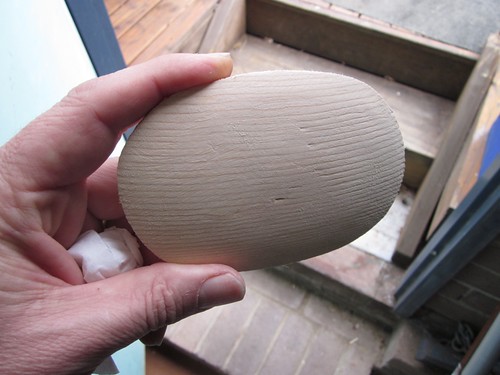
And here's the patch glued in and trimmed:

You can see how nicely it fits at the edges. I'm pretty happy how it turned out Smile
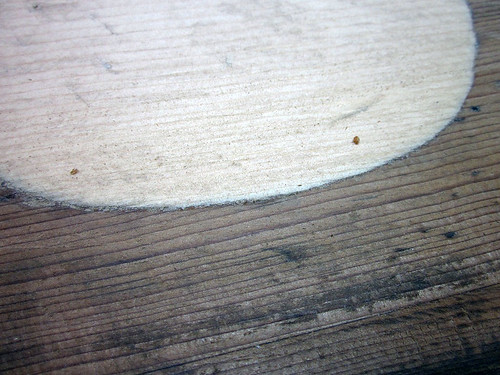
I decided that I *would* shave the thin dark layer off the surface of the wood, at least as far as the bass bar, and I'm glad that i did. These patches look as if they are reinforcing the main centre glue line.
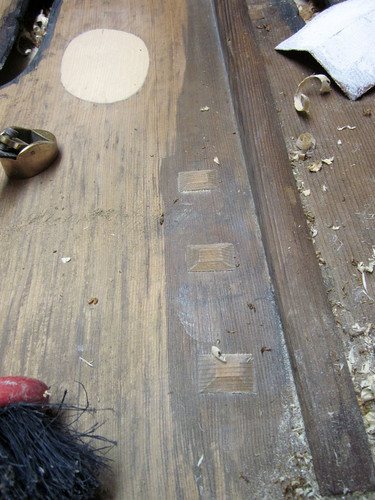
But when the dark layer is removed, it's very clear that there's another previous crack there that I couldn't see before (see next pic). It's a bit of a pity to remove the dirt/patina, but going back to clean wood is going to allow me to make better repairs, and as the purpose is to result in a functional bass, I think the decision is sensible.
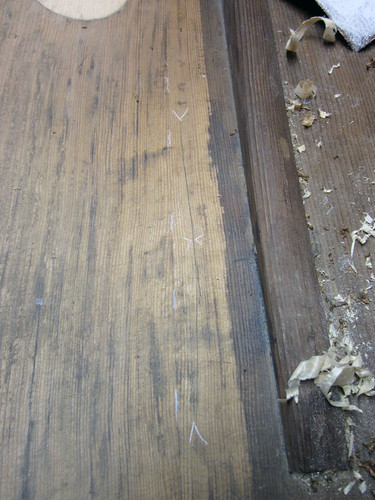
This is a nice view of repaired top to date.
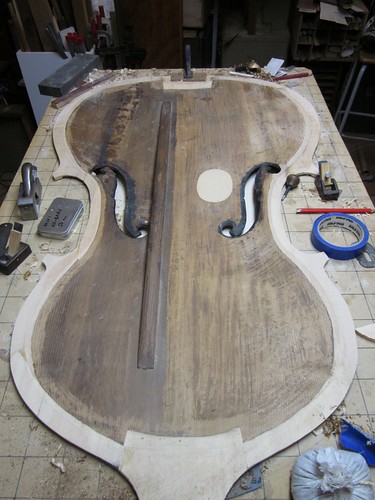
We've made it from here:
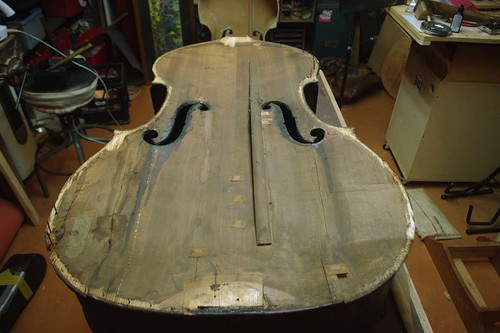
to here:
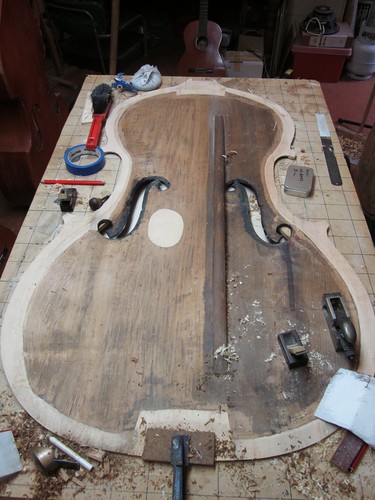
And I really MUST do something about getting a consistent colour-balance!

And here's the patch glued in and trimmed:

You can see how nicely it fits at the edges. I'm pretty happy how it turned out Smile

I decided that I *would* shave the thin dark layer off the surface of the wood, at least as far as the bass bar, and I'm glad that i did. These patches look as if they are reinforcing the main centre glue line.

But when the dark layer is removed, it's very clear that there's another previous crack there that I couldn't see before (see next pic). It's a bit of a pity to remove the dirt/patina, but going back to clean wood is going to allow me to make better repairs, and as the purpose is to result in a functional bass, I think the decision is sensible.

This is a nice view of repaired top to date.

We've made it from here:

to here:

And I really MUST do something about getting a consistent colour-balance!
Re: Old French Bass full Restoration
As with everyone that has posted its fun to watch and learn too.
Matthew have you kept any record of the hours you have spent on this repair
so far?
Matthew have you kept any record of the hours you have spent on this repair
so far?
Cheers Luke
- matthew
- Blackwood
- Posts: 1193
- Joined: Mon Oct 08, 2007 1:16 pm
- Location: Sydney, Inner West
- Contact:
Re: Old French Bass full Restoration
That's exactly what my wife saidLuke wrote:Matthew have you kept any record of the hours you have spent on this repair so far?
My reply was that it is difficult to be precise, given that i work on it in short bursts, sometimes 10 minutes at a time to glue someting up then i leave it overnight ... then a few minutes to remove the clamps ...
Kind of why I'm taking photos, it reminds me of the detail of the job and how long it took.
- matthew
- Blackwood
- Posts: 1193
- Joined: Mon Oct 08, 2007 1:16 pm
- Location: Sydney, Inner West
- Contact:
Re: Old French Bass full Restoration
On another site there's been some comment about whether or not to remove the internal patina. I was wondering about scraping the nice old dark surface back to clean wood. Eventually I made a judgement that it would be better to shave a very thin layer off and make sure I make good glue repairs, than leaving it there for the looks only. The wood is still darkened with oxidation, and there is no doubt about the age of the instrument.
Here you can clearly see what I'm doing.
On the left hand side is the colour of the wood as the bass came to me. Yes it is oxidised but also has traces of old glue and no doubt tobacco smoke and other muck. You can clearly see the white new wood i have added, and then the areas I have scraped back to clean old wood in the foreground. I've left, for the moment, a strip alongside the bass bar. If I decide to leave the bar, I'll leave the dark strip as well. If I decide to replace the bar, I'll probably scrape it back too.
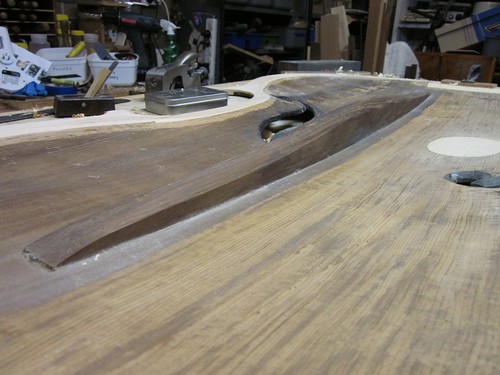
The bar looks original, is fairly hefty, and is well-attached. It is however glued exactly parallel with the centre joint, which is not modern practice. At the moment I'm inclined to leave it in place, perhaps reshape it a little, but I'll reserve my decision after the top is fully together and I've had a chat with the client.
Here you can clearly see what I'm doing.
On the left hand side is the colour of the wood as the bass came to me. Yes it is oxidised but also has traces of old glue and no doubt tobacco smoke and other muck. You can clearly see the white new wood i have added, and then the areas I have scraped back to clean old wood in the foreground. I've left, for the moment, a strip alongside the bass bar. If I decide to leave the bar, I'll leave the dark strip as well. If I decide to replace the bar, I'll probably scrape it back too.

The bar looks original, is fairly hefty, and is well-attached. It is however glued exactly parallel with the centre joint, which is not modern practice. At the moment I'm inclined to leave it in place, perhaps reshape it a little, but I'll reserve my decision after the top is fully together and I've had a chat with the client.
- Nick
- Blackwood
- Posts: 3628
- Joined: Thu Feb 26, 2009 11:20 am
- Location: Christchurch, New Zealand
- Contact:
Re: Old French Bass full Restoration
*Shakes head in amazement*
Great stuff Matthew, enjoying every post. Your table interests me, the grid on it is to help to get measurements when making replacement pieces?
Great stuff Matthew, enjoying every post. Your table interests me, the grid on it is to help to get measurements when making replacement pieces?
"Jesus Loves You."
Nice to hear in church but not in a Mexican prison.
Nice to hear in church but not in a Mexican prison.
- matthew
- Blackwood
- Posts: 1193
- Joined: Mon Oct 08, 2007 1:16 pm
- Location: Sydney, Inner West
- Contact:
Re: Old French Bass full Restoration
The grid was originally a way of trying to calculate the surface area of a top.
Now, it helps me centre the top in the cutout.
Now, it helps me centre the top in the cutout.
- J.F. Custom
- Blackwood
- Posts: 778
- Joined: Fri May 01, 2009 9:13 pm
- Location: Brisbane
- Contact:
Re: Old French Bass full Restoration
That is just sensational work Matthew. I can't imagine that the client won't be stunned by the level of commitment and quality you have shown in this repair job.
Overall, it is a good reminder to me as to why I avoid taking on repairs! Scary stuff to see what it was originally - yet you have managed to bring it back impressively. Kudos to you.
I was particularly interested in how you were going to patch that dish/scoop when you detailed the removal of it. So I assume you used the chalk to 'highlight' areas of the patch until you had a solid complete fit? The result looks perfect.
Oh, and for what it is worth, which may not be much mind you and it may raise a purists eyebrow or two but... A judgement call it was and I believe you made the right one regarding the internal patina. The wood still appears old and rich in appearance, though not so dirty. Someone who had not seen the before and after would still appreciate the beauty of the aged timber inside. But importantly, it allowed for a more accurate appraisal of the tops condition, which after all, is higher on the priority for restoration to a playable condition as required in this job. I would have made the same call.
Thanks for the effort of posting.
Jeremy.
Overall, it is a good reminder to me as to why I avoid taking on repairs! Scary stuff to see what it was originally - yet you have managed to bring it back impressively. Kudos to you.
I was particularly interested in how you were going to patch that dish/scoop when you detailed the removal of it. So I assume you used the chalk to 'highlight' areas of the patch until you had a solid complete fit? The result looks perfect.
Oh, and for what it is worth, which may not be much mind you and it may raise a purists eyebrow or two but... A judgement call it was and I believe you made the right one regarding the internal patina. The wood still appears old and rich in appearance, though not so dirty. Someone who had not seen the before and after would still appreciate the beauty of the aged timber inside. But importantly, it allowed for a more accurate appraisal of the tops condition, which after all, is higher on the priority for restoration to a playable condition as required in this job. I would have made the same call.
Thanks for the effort of posting.
Jeremy.
-
Pete Howlett
- Myrtle
- Posts: 89
- Joined: Fri Oct 15, 2010 8:08 pm
Re: Old French Bass full Restoration
We who don't do repairs are not worthy 
Re: Old French Bass full Restoration
Feel this deserves the descriptive "resurrection" above "repair". Amazing - thanks.
Re: Old French Bass full Restoration
Great work Matthew...did I mention just how valuable your posts are to the forum? Good for all in this, your client is lucky to have found you.
Cheers
Kim
Cheers
Kim
- matthew
- Blackwood
- Posts: 1193
- Joined: Mon Oct 08, 2007 1:16 pm
- Location: Sydney, Inner West
- Contact:
Re: Old French Bass full Restoration
OK you guitar folk ... what does THIS tell you?
33.5Hz

45Hz
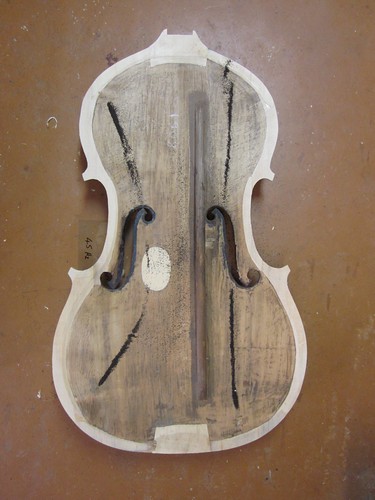
77Hz

98Hz
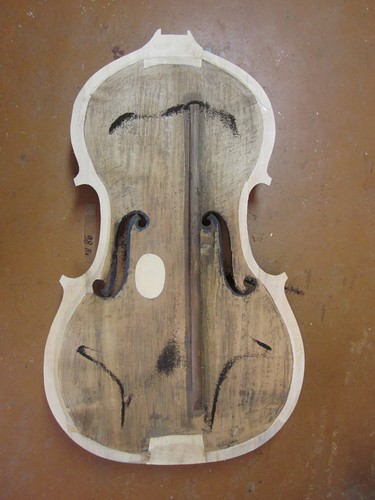
119Hz
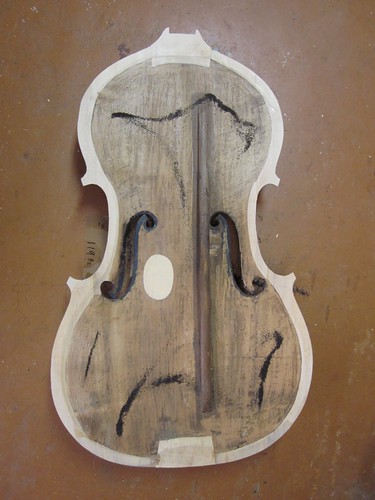
the plate weighs 1908g.
Re: Old French Bass full Restoration
You subjected it to vibration with some black powder on it and it was more symetrical at 98Hz than at 119hz. That the upper bouts play a stronger role in this shape than they do in a guitar. That whoever built it had a fair idea of what they were doing.
Does it have a soundpost on the treble side of the bridge in its final form?
Does it have a soundpost on the treble side of the bridge in its final form?
Re: Old French Bass full Restoration
It tells me that Picasso was into bass repairs using Chilandri patterns long before he took up the brush.matthew wrote:OK you guitar folk ... what does THIS tell you?
More seriously, my 'totally' unqualified opinion is that these patterns are indicating that the plate is becoming a little too restricted at the higher frequencies. I say this because of the nodal point of inactivity which start to develop and move toward the lower centre of the lower bout from 77Hz through 119Hz. My solution would be to remove some of the material that is not bass from that big stick that is glued off centre.
Cheers
Kim
Re: Old French Bass full Restoration
I was wondering if a soundpost might alter that aspect.
- John Maddison
- Blackwood
- Posts: 354
- Joined: Tue Jun 03, 2008 11:15 pm
- Location: Albany, Western Australia
- Contact:
Re: Old French Bass full Restoration
That I (we?) would like to see some close up side-on images of your sound-testing set up, and a quick run down of the oscillator type, amplification & speaker rig. Like all others am enjoying the ongoing progress of this thread.matthew wrote:... what does THIS tell you?
Also, what is a 'standard' frequency range of a double bass just out of curiosity? ... Thanks Matthew!
John M
- matthew
- Blackwood
- Posts: 1193
- Joined: Mon Oct 08, 2007 1:16 pm
- Location: Sydney, Inner West
- Contact:
Re: Old French Bass full Restoration
Macbook pro running a freeware tone generator into a HiFi amp connected to a heavy 12" woofer which I hold over the plate. The plate is resting on a piece of foam where the bridge would be. That's about all there is to it. I start at about 19 Hz and wind up the frequency till the modes appear. Tea-leaves. You have to be able to feel the modes a bit to know where best to put the speaker. When the resonance happens the edges of the plate oscillate by up to a centimeter - quite spectacular!
It tells you nothing about how the plate will vibrate when attached to the top and the soundpost is installed.
Also, there is no standard with basses!
It tells you nothing about how the plate will vibrate when attached to the top and the soundpost is installed.
Also, there is no standard with basses!
-
reconstructor
- Wandoo
- Posts: 14
- Joined: Mon Oct 25, 2010 10:06 pm
Re: Old French Bass full Restoration
Reply by "Darryl Young"
If you don't mind me asking, is there a purpose for the soundpost in a bass other than structural? I've heard it tames down the "screech" on a violin but not sure that would be happening on a bass. How do you decide how much to pre-load the top before it makes contact with the back/soundpost? Seems this preload would change things. I've know of one bass used to play bluegrass music that went from so-so on the D & G strings and pathetic on the E & A strings to an amazing instrument just by shortening the soundpost where the top was pre-loaded before it made contact with the back. The downside is the soundpost will fall over when the strings are removed.
If you don't mind me asking, is there a purpose for the soundpost in a bass other than structural? I've heard it tames down the "screech" on a violin but not sure that would be happening on a bass. How do you decide how much to pre-load the top before it makes contact with the back/soundpost? Seems this preload would change things. I've know of one bass used to play bluegrass music that went from so-so on the D & G strings and pathetic on the E & A strings to an amazing instrument just by shortening the soundpost where the top was pre-loaded before it made contact with the back. The downside is the soundpost will fall over when the strings are removed.
Re: Old French Bass full Restoration
Does the type of tea leaves used affect the modes? I suspect peppermint tea would improve clarity of the sound whereas Camomile would give you a more relaxed tone?matthew wrote:Tea-leaves. You have to be able to feel the modes a bit to know where best to put the speaker.
Feeling the modes.....putting on your Captain Bumble Bee outfit would certainly help here.
Martin
- matthew
- Blackwood
- Posts: 1193
- Joined: Mon Oct 08, 2007 1:16 pm
- Location: Sydney, Inner West
- Contact:
Re: Old French Bass full Restoration
yes Martin the type of tealeaves is critical. I use earl grey for an elegant and refined tone. As far as feeling for the modes is concerned, position is everything. The contra-sutra is essential reading. I assume you have that book?
- DarwinStrings
- Blackwood
- Posts: 1873
- Joined: Thu Nov 13, 2008 10:27 pm
- Location: Darwin
Re: Old French Bass full Restoration
Hmmm is that tea with real Bergamot oil or will the modern Bergamot oil flavor type do? and how helpful would a Gypsy woman be to have around while you are doing that?
Jim
So the point of the exercise is just a bit of fun?matthew wrote:It tells you nothing about how the plate will vibrate when attached to the top and the soundpost is installed.
Also, there is no standard with basses!
Jim
Life is good when you are amongst the wood.
Jim Schofield
Jim Schofield
Re: Old French Bass full Restoration
Can't help feeling that really well dried coffee grounds would have given ..... 
- matthew
- Blackwood
- Posts: 1193
- Joined: Mon Oct 08, 2007 1:16 pm
- Location: Sydney, Inner West
- Contact:
Re: Old French Bass full Restoration
OK.
Coffee grounds are NOT a good idea. i tried it once. They stick to the plate and stink to high heaven.
For me the Chladni patterns are merely a way of measuring in a pictorial way the flexibility of a plate. The plates all exhibit these "modes" of resonance to one degree or another. The lower the frequency at which the modes appear, the more flexible the plate and vice versa. Each mode means something slightly different, for example the first mode is a twisting mode where at this frequency the top and bottom bouts are oscillating in opposite directions. In the second mode they are moving in the same direction, and the centre of the plate is "pumping" the other way. Third and fourth modes are complex interactions between the first, second and fifth modes. The fifth mode shows the nodes of resonance where the plate is flexing longitudinally.
Obviously the wood is stiffer this way so the frequency is higher.
On their own the patterns mean little. However when you have a number of different plates measured this way you can start to analyse and make some educated guesses as to what and why. For me, luthiery isn't a science; it is a series of educated hunches, and the better your hunches the better you are as a luthier.
What I glean from the fact that the lowest modes are at a higher frequency that the modes on the other basses I have measured, is that this plate is still quite stiff. How much i might try to lighten or un-stiffen the plates is a matter of following a hunch.
And yes its a barrel of fun, especially if you can convince a gypsy woman with a crystal ball to hang around for a while too!
Coffee grounds are NOT a good idea. i tried it once. They stick to the plate and stink to high heaven.
For me the Chladni patterns are merely a way of measuring in a pictorial way the flexibility of a plate. The plates all exhibit these "modes" of resonance to one degree or another. The lower the frequency at which the modes appear, the more flexible the plate and vice versa. Each mode means something slightly different, for example the first mode is a twisting mode where at this frequency the top and bottom bouts are oscillating in opposite directions. In the second mode they are moving in the same direction, and the centre of the plate is "pumping" the other way. Third and fourth modes are complex interactions between the first, second and fifth modes. The fifth mode shows the nodes of resonance where the plate is flexing longitudinally.
Obviously the wood is stiffer this way so the frequency is higher.
On their own the patterns mean little. However when you have a number of different plates measured this way you can start to analyse and make some educated guesses as to what and why. For me, luthiery isn't a science; it is a series of educated hunches, and the better your hunches the better you are as a luthier.
What I glean from the fact that the lowest modes are at a higher frequency that the modes on the other basses I have measured, is that this plate is still quite stiff. How much i might try to lighten or un-stiffen the plates is a matter of following a hunch.
And yes its a barrel of fun, especially if you can convince a gypsy woman with a crystal ball to hang around for a while too!
Re: Old French Bass full Restoration
Arabica or Robusta grounds?Puff wrote:Can't help feeling that really well dried coffee grounds would have given .....
Martin
- matthew
- Blackwood
- Posts: 1193
- Joined: Mon Oct 08, 2007 1:16 pm
- Location: Sydney, Inner West
- Contact:
Re: Old French Bass full Restoration
I have grounds to believe you're havin' a laff, Martin.
How's that lute coming on, anyway?
How's that lute coming on, anyway?
Who is online
Users browsing this forum: No registered users and 41 guests